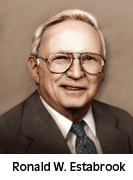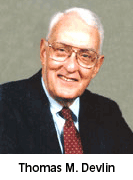1969 was an eventful year. The country was suffering with internal conflict over involvement in the Vietnam War. This led to the decision in 1968 by President Lyndon Baines Johnson not to seek reelection. Richard M. Nixon was elected President leading to a change of political power. in Washington. There was a feeling of apprehension about the future funding of biomedical research and research training - greater than normal. The potential of dramatic advances associated with the growth of molecular biology were on the horizon. There was reported to be a shortage of physicians and this led to the establishment of federal programs that provided generous rewards (in the form of new construction and funding for faculty) if medical schools were to significantly expand their enrollment and new medical schools established. The increase in class size at many medical schools, combined with the establishment of new medical schools designed to train generalist physicians, resulted in an emphasis to develop new methods of teaching and a reorganization of departmental structures, in particular in the basic sciences. It was this environment that led to the formation of an organization originally called the Association of Chairmen of Biochemistry Departments in Medical Schools. It is fair to say that no single individual deserves the credit for the initiation of this organization. As we recall, the present organization developed from conversations at the Federation Meeting in Atlantic City in the Spring of 1969. Two events may have been responsible for the timing. First, one of us, Tom Devlin (a recently appointed Chairman of Biochemistry at Hanemann Medical School) expressed frustration with the American Society of Biological Chemistry over the absence (and lack of interest of the Society Council) in matters related to education - in particular the teaching of Biochemistry in a medical school. Efforts to establish an oral session for presentation of issues related to educational activities of biochemistry in competition with scientific presentations (i.e., during the scheduled hours of the Federation Meeting) were rebuffed by the Program Committee and the ASBC Council. Many of us felt that education had been relegated the role of an appendage to be presented only during off-hours of the annual ASBC meeting. Second, one of us, Ron Estabrook (a newly appointed Chairman of Biochemistry at the University of Texas Southwestern Medical School at Dallas), was appointed as representative of the American Society of Biological Chemistry to the Council of Academic Societies of the AAMC where he gained knowledge of activities by Chairmen organizations of other basic science disciplines taught in medical schools. During September and October, 1969 Devlin and Estabrook drafted a letter which was sent to all Chairmen of Biochemistry Departments in medical schools seeking their interest in meeting during the Federation Meeting, to be held in Atlantic City, NJ, in the Spring of 1970. The response was overwhelming (over 60 letters of support for the idea) and many respondents included suggestions of topics for discussion. Most of these related to graduate student training, the role of laboratory work in the teaching of medical students, the value of the National Board Examination, advanced placement of medical students who had completed a course of biochemistry in their undergraduate training, the role of an Administrative Assistant for a department of Biochemistry etc. Most of these topics seem appropriate for an agenda of a meeting in the 1990's. Of great interest was one response from Santiago Grisolia, Chairman of the Department of Biochemistry of the University of Kansas Medical Center informing us that a similar effort to organize the Chairmen of Biochemistry Departments had taken place two years earlier (April 20, 1967) at the Federation meeting in Chicago. This earlier meeting was attended by twelve department chairmen who endorsed the concept of such an organization - but apparently this initial attempt at organization was never followed up. Based on the positive response received to the mailing from Devlin and Estabrook an agenda was developed for a meeting to be held Sunday night, April 12th in the Garden Room of the Haddon Hall Hotel, Atlantic City, NJ. The agenda was initially loosely constructed but soon became more complex as new issues were added to the list. Particular concern focused on the challenge to training grants (in particular the proposal to abandon training grants in favor of a loan program) and it was arranged that Russell Hilmoe, Administrator of the Biochemistry Training Program at NIH would come to speak to the group. Following the meeting in Atlantic City, Estabrook sent a memo to the Department Chairmen dated May 14, 1970) including the statement developed by Emil Smith's committee concerning the issue of a loan program for the support of graduate students, the need for questions for the Question Bank developed by Armand Guarino, the minutes of the meeting in Atlantic City written by Tom Devlin, and the plans to hold the next Department Chairmen's meeting at the D.H. Lawrence Ranch in the Sangre del Christo Mountains north of Albuquerque. On July 21, 1970 Estabrook sent a memo to the Department Chairmen enclosing copies of letters from Lamont-Havers of NIH and Mark Alger of OMB concerning the issue of a loan program replacing training grants. Of interest is the role of George Bush (then a Congressman from Texas) played as intermediary in these negotiations. On November 19, 1970 Estabrook sent a memo describing plans for the 2nd meeting of the Chairmen of Departments of Biochemistry. This was to be held at the D.H. Lawrence Ranch (owned by the University of New Mexico) north of Taos. 108 people (including wives) signed up for this meeting. It was an unforgetable experience which has generated many stories of life in the rugged mountains of New Mexico on a cold February night. The very complete minutes prepared by Tom Devlin for this meeting capture the intensity of discussions and the importance of many issues to the continued viability of Biochemistry Departments. The 3rd meeting of the ADBMS was held in June, 1971 in San Francisco, CA during the annual meeting of the ASBC. The 4th meeting of Biochemistry Chairmen's group was in Miami, FL on January 8 and 9, 1972 in conjunction with the Miami Winter Symposium organized by Bill Whelan and Julius Schultz. (The choice of Miami reflects the groups first experience with a meeting in the cold weather of New Mexico. In addition the ability to combine the Chairmen's meeting with a scientific meeting added to the attractiveness of Miami). AMGDB Commentaries |


